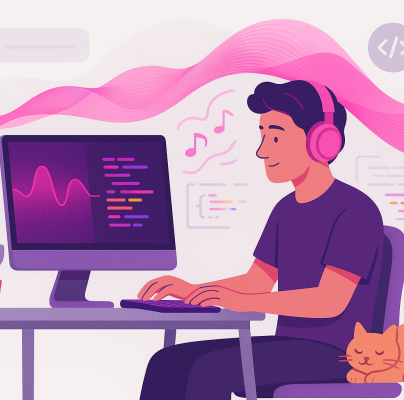While AI coding tools can generate impressive proofs of concept and help non-developers bring ideas to life, professional developers remain essential for creating secure, maintainable products. At Versantus, our AI-augmented development team helps you get further, faster; taking your vibe-coded concepts and transforming them into production-ready solutions.
What's vibe coding?
Vibe coding is the process of generating functional code by describing what you want to an AI tool. No coding knowledge required; just explain your idea, and within seconds, you have working code.
"I want a website that shows weather forecasts with music based on conditions."
30 seconds later
"Here's your HTML, CSS, and JavaScript. Don't forget to add your API keys!"
It's a powerful capability, but like all tools, it comes with responsibility. Let's explore what makes vibe coding brilliant and where caution is needed.
You don't know what you don't know
The Dunning-Kruger effect, named after psychologists David Dunning and Justin Kruger, describes that initial burst of confidence when learning something new. Beginners overestimate their abilities before experiencing the reality check that comes with deeper knowledge.
With vibe coding, this effect is amplified. You're catapulted from novice to "look at my working code!" without climbing the learning curve.
What you bypass isn't just coding syntax, but understanding why certain practices exist:
- Security best practices
- Performance considerations
- Maintainability
- Scalability across user bases and data volumes
- Testing and quality assurance
- UX design principles and accessibility standards
- Domain expertise and industry best practices
- Human-centered empathy for diverse user needs
- Future-proofing and technical debt management
This gap in understanding can lead to trouble down the line.
UX design isn't merely about making things look nice. It's about creating interfaces that people can navigate intuitively, regardless of their abilities or limitations. AI might generate code that works, but it rarely accounts for colour contrast ratios that assist visually impaired users, keyboard navigation for people who can't use a mouse, or screen reader compatibility. True accessibility requires human empathy; understanding how different people experience technology and designing with their needs in mind.
Similarly, domain expertise can't be vibe coded. A healthcare application needs to consider patient confidentiality. An e-commerce platform must understand payment regulations. A logistics system needs to account for real-world constraints. These nuances come from years of industry experience and close collaboration with experts who understand the domain deeply. AI tools may know syntax, but they don't attend industry conferences, talk to customers, or understand the unwritten rules that govern specific sectors.
Security concerns
AI coding tools excel at generating functional code but don't always prioritise security. After all, they're responding to what you ask for, and most people aren't asking about input sanitisation or cross-site scripting prevention.
A common issue is the handling of API keys:
// Please don't do this 🙈 const OPENWEATHER_API_KEY = "ab12c34d5ef67gh89ij0klmno";
That innocent line, committed to a public repository, could lead to unexpected bills or someone using your credentials maliciously. AI tools often generate code with API key placeholders without emphasising the importance of keeping them secure.
The valley of bugs (and bills)
Vibe-coded projects typically follow this pattern:
- Peak of excitement: "It works! I built something!"
- Plateau of additions: "Let me add a few more features..."
- Cliff of complexity: "Why is everything breaking now?"
- Valley of bugs: "I need a developer to fix this mess."
What started as a quick project becomes a tangled web that no one fully understands – not even the AI that helped create it.
This is where professional developers become essential. Not just to fix bugs, but to rebuild with intention, structure, and foresight.
AI-augmented development: the best of both worlds
So how do we harness the power of vibe coding without falling into its traps? This is where the true magic happens.
At Versantus, we've developed a hybrid approach that combines the speed and innovation of AI with the expertise and judgment of professional developers. We call it AI-augmented development, and it's transforming how we build software.
Our developers use AI to:
- Generate starter code for routine tasks
- Explore alternative approaches
- Prototype features quickly
- Document code thoroughly
- Debug complex issues
But we bring human expertise to the equation. Our developers understand the "why" behind coding practices, identify security vulnerabilities, and structure applications for long-term maintenance.
Take your vibe to the next level
Where does this leave you, the idea-haver who's discovered vibe coding?
In an excellent position. You can:
- Use AI tools to validate ideas quickly
- Create working prototypes to show stakeholders
- Explore possibilities without huge investment
- Learn basic coding alongside your AI assistant
- Partner with professionals when ready to build something robust
When you come to Versantus with your vibe-coded prototype, you're not starting from scratch. You're bringing a tangible vision that our team can understand, refine, and transform into a professional application.
The bottom line
Vibe coding lowers the barrier to entry and helps more ideas come to life. But like any powerful tool, it works best paired with expertise.
At Versantus, our AI-augmented development team bridges the gap between AI-generated code and production-ready applications. We help you get further, faster; without sacrificing security or quality.
Ready to take your vibe-coded concept to the next level? Let's chat about how we can help.

